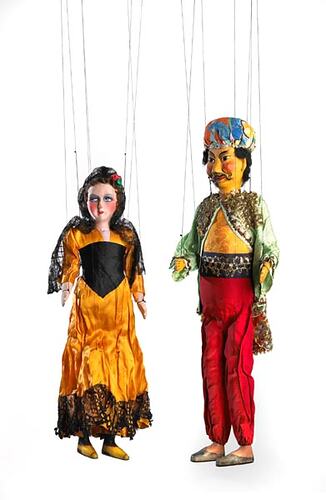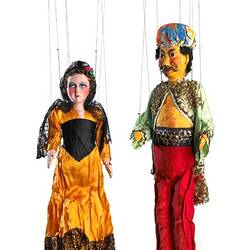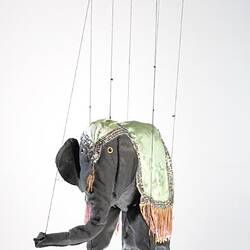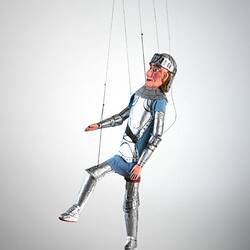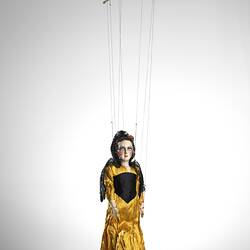On May 11th, 1935, the Melbourne newspaper The Argus wrote about a local theatre company which comprised of `150 actors who sleep in a storeroom'. Almost 70 years later, and 50 years after their last performance, the same group awoke from their slumber and made a journey to Museum Victoria. They were the puppets from `Le Forgeron Marionettes', a long forgotten troupe of players who were eager to relive their former glory.
Their revival began in 2002, when the museum received a phone call informing us of the collection, now hidden away in a suburban garage. As is often the case when such calls are received, the owners were shifting to smaller accommodation and were looking for a suitable home for their treasured family heirlooms. A visit to their home revealed a pile of well worn suitcases and trunks, from which emerged an assortment of wondrous storybook characters and creatures.
The collection of marionettes were made and operated by the donor's grandfather, Alex Smith, and his family from the late 1920s until the mid 1950s. A scrapbook of programs and clippings revealed that they performed all over Melbourne, receiving rave reviews in the press. It was not until the introduction of television in 1956 that their popularity began to wane, and the company folded a short time later.
Scottish born Smith had taken up puppetry as a hobby when he was a boy, and gave his first performance aged ten. He trained to be a cabinet maker, specialising in Jacobean furniture, but puppets were still his first love. Moving to London, he found more opportunities to perform, and was able to further develop both his performance skills and marionette designs.
In 1927 he moved his family to Melbourne, where his hobby eventually became a full time occupation. He established a troupe named `Le Forgeron' (French for `The Blacksmith'), a play on the family name 'Smith', to give the company a more sophisticated European flavour. Even years after immigrating to Australia, Le Forgeron Marionettes were still being promoted as coming 'Direct from London'.
The Smith family, including Alex's wife and son, were totally self sufficient, and made all the marionettes, dressed them, constructed the sets, wrote the scripts, and carried out all the onstage and backstage functions needed to perform the plays. In later years, the son Murray ran his own printing works, which was used to print all the flyers, posters and programs Le Forgeron needed.
On the 25th September 1937 Smith realised a long standing ambition, and opened a purpose built 200-seat theatre in St Kilda's landmark Luna Park. Opening in time for the park's silver jubilee celebrations, it was an instant hit with patrons of all ages. It was Australia's first, and possibly only, purposely built puppet theatre, boasting air conditioning, full lighting facilities and sound amplification.
As well as their permanent theatre, which operated only in the warmer months, the company performed around Melbourne at department stores, schools, town halls, church functions, private parties and various charity events. The collection was transported in trunks and suitcases in the family's Ute, along with the parts for a five metre portable stage.
When the family stopped performing in 1956 due to the introduction of television and the family's desire to do other, less nomadic, things the collection was put into storage at Murray's printing works. Unfortunately a flood in the early 1970s ruined the painted backdrops, but fortunately the carefully packed marionettes were spared any significant damage. The collection was then relocated and spent the next 30 years in the family garage until the Museum was alerted to it.
The collection arrived at the Museum with a small archive of newspaper clippings, programs, scripts and other documents, which gives an intriguing insight into the history and operation of 'Le Forgeron Marionettes'. A short film segment from a 1939 Cinesound Newsreel has been sourced from Screensound, showing Alex and Murray Smith performing with the marionettes at their Luna Park Theatre. The family are also tracking down colour transparencies showing the marionettes in action.
The Le Forgeron Marionette Theatre collection is significant addition to the Museum's Leisure Collection as a rare surviving example of the travelling performing troupes which regularly toured throughout Australia until the 1960s. It compliments the Museum's other two puppet collections (Karagiozis Shadow Puppet collection and William Nicol Shadow Puppet collection), as well as the Harry Johns Boxing Troupe collection, as another example of a 'mobile' entertainment provider.
The collection also reflects Melbourne's reputation as a centre of creativity in all aspects of puppetry. It also compliments the puppet material held by the Performing Arts Collection at the Victorian Arts Centre. Their treasures range from well-known and beloved iconic characters such as Hey, Hey It's Saturday's Ossie Ostrich and Shirl's Neighbourhood's Claude the Crow to puppets created by J.F. Ley, Joan and Betty Raynor, Pilgrim Puppets, Polyglot and Handspan for theatre audiences at home and abroad.
The collection is also significant for its links to the iconic St Kilda landmark 'Luna Park', which has been operating in the same location since 1912. Very little material culture exists of the past attractions of Luna Park, especially pre World War 2, as most of the park's records were destroyed in the Giggle Palace fire in 1981. So this collection would be an important resource for any exhibition looking at Luna Park, or the History of St Kilda as a recreational venue for Melburnians. The marionettes have a direct link to Luna Park's wartime operation, when it proved a popular venue for the American Servicemen stationed in Melbourne as it reminded many of similar amusement parks back in the States.
The collection is also linked to Melbourne retailing history, as Le Forgeron regularly performed during Christmas and school holidays at stores such as Myer, Buckley and Nunn, Foy & Gibsons, Dimmeys and Mantons, representing the kinds of entertainment enticements offered by such establishments to draw in customers.
A selection of puppets was put on display in 2004 as part of the Museum's 150th celebrations. It proved to be a popular exhibit, both with older adults who remembered seeing Le Forgeron in operation, and with children of all ages who were enticed by sheer exquisiteness and playfullness of the marionettes. After a break of 50 years Le Forgeron was again sharing its magic with the people of Melbourne. Half a century later characters such as Queen Bess, the Ogre, the Sultan, the Bear Ballet and the Big Bad Wolf finally had a new home, ready to enthral new audiences for years to come.
More Information
-
Keywords
puppet shows, Advertising, American Military Forces, Amusement Parks, Christmas, Cinema, Department Stores, Entertainers, Entertainment, Entertainment Workers, Leisure, News Clippings, Performances, Performers, Performing Arts, Puppetry, Puppets, Recreation, Retailing, Scottish Immigration, Servicemen, Theatres, Theatrical Performances, World War II, 1939-1945
-
Localities
Melbourne, Victoria, Australia, St Kilda, Victoria, Australia
-
Authors
-
Article types
